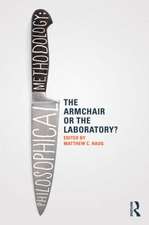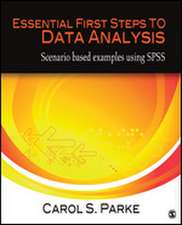Qualitative Communication Research Methods
Autor Thomas R. Lindlof, Bryan C. Tayloren Limba Engleză Paperback – 5 feb 2018
Preț: 814.94 lei
Preț vechi: 1101.27 lei
-26% Nou
155.94€ • 163.36$ • 129.24£
Carte disponibilă
Livrare economică 18 martie-01 aprilie
Livrare express 04-08 martie pentru 33.77 lei
Specificații
ISBN-10: 1452256829
Pagini: 520
Dimensiuni: 152 x 229 x 26 mm
Greutate: 0.61 kg
Ediția:Fourth Edition
Editura: SAGE Publications
Colecția Sage Publications, Inc
Locul publicării:Thousand Oaks, United States
Recenzii
“The book is exceptionally well written and easy to read even for students who know nothing about research methods.”
“The engaging and accessible (generally) nature of writing is excellent and provides good inspiration and a good foundation to build on in terms of introductions to key steps and dimensions in qualitative research. The referencing of examples from ‘real’ research is attractive to lecturers and students alike and makes the introduction to qualitative research come alive.”
“An insightful and thoroughly researched book that will be extremely helpful for students aiming to engage with qualitative research at a deeper level.”
Cuprins
Acknowledgments
About the Authors
Chapter 1. Introduction to Qualitative Communication Research
Rounding the (Paradigm) Bases: A Brief History of Qualitative Communication Research
Covering New Material(ism), Going Big: Two Trends in Qualitative Communication Research
Conclusion
Exercises
Chapter 2. The Diversity of Qualitative Research in Communication Subfields
Baker’s Dozen: Thirteen Subfields, Thirteen Stories of Qualitative Communication Research
Conclusion
Exercises
Chapter 3. Theoretical Traditions and Qualitative Communication Research
Introduction: “What Would You Like on Your Sandwich?”
The Phenomenological Tradition
The Sociocultural Tradition
Critical Theories
Conclusion
Exercises
Chapter 4. Design I: Planning Research Projects
Introduction
“My City, My Society, and My Life”: Renee’s Story
Sources of Research Ideas
Evaluating the Scene
Conclusion
Exercises
Chapter 5. Design II: Implementing Research Projects
Introduction
Negotiating Access
Exploratory and Mixed Methods
Sampling
Human Subject Protections
The Research Proposal
Conclusion
Exercises
Chapter 6. Producing Data I: Participation, Observation, and Recording Communication
Introduction: Welcome to Fieldwork
Ethnography and Participant Observation
Successful Participant Observation
Adapting Roles
Tactical Observing
Writing Fieldnotes
Conclusion
Exercises
Chapter 7. Producing Data II: Qualitative Interviewing
Introduction
Purposes of the Qualitative Interview
Types of Interviews in Communication Research
Interviewing Practices
Question Design and Use
Transcribing Interviews
Conclusion
Exercises
Chapter 8. Producing Data III: Studying Materiality
Introduction
Material Culture
Documents
Conclusion
Exercises
Chapter 9. Sensemaking I: Analyzing, Coding, and Managing Data
Introduction
Qualitative Data Analysis: An Overview
In-Process Writing
Categories and Codes
Grounded Theory
Coding Examples
Leaving the Field
Tools for Analysis
Conclusion
Exercises
Chapter 10. Sensemaking II: Creating, Evaluating, and Enhancing Interpretations of Data
Introduction
Creating Interpretations
Evaluating Interpretations
Enhancing Interpretations
Conclusion
Exercises
Chapter 11. Writing, Authoring, and Publishing
Introduction: Going Public
The Crisis of Representation
After the Fall: Reading and Writing Qualitative Research
Institutional Contexts of Qualitative Writing
The Craft of Qualitative Writing: Three Types of Formats and Their Related Strategies
Some Final Thoughts on Writing
Exercises
Epilogue
References
Author Index
Subject Index
Notă biografică
Thomas R. Lindlof is a professor in the School of Journalism and Media at the University of Kentucky. His research and teaching interests focus on the cultural analysis of mediated communication, media audience theory and research, and qualitative research methodology. His research has appeared in numerous scholarly outlets, including Communication Research, Journal of Communication, Journal of Broadcasting & Electronic Media, Journalism Quarterly, Journalism Studies, Social Science Computer Review, and Communication Yearbook. He has served as the editor of the Journal of Broadcasting & Electronic Media. He has written or edited six books, including Qualitative Communication Research Methods (with Bryan C. Taylor) and Hollywood under Siege: Martin Scorsese, the Religious Right, and the Culture Wars. In 2011 he received the Distinguished Scholar Award from the Broadcast Education Association. He currently resides in Austin, Texas.






















